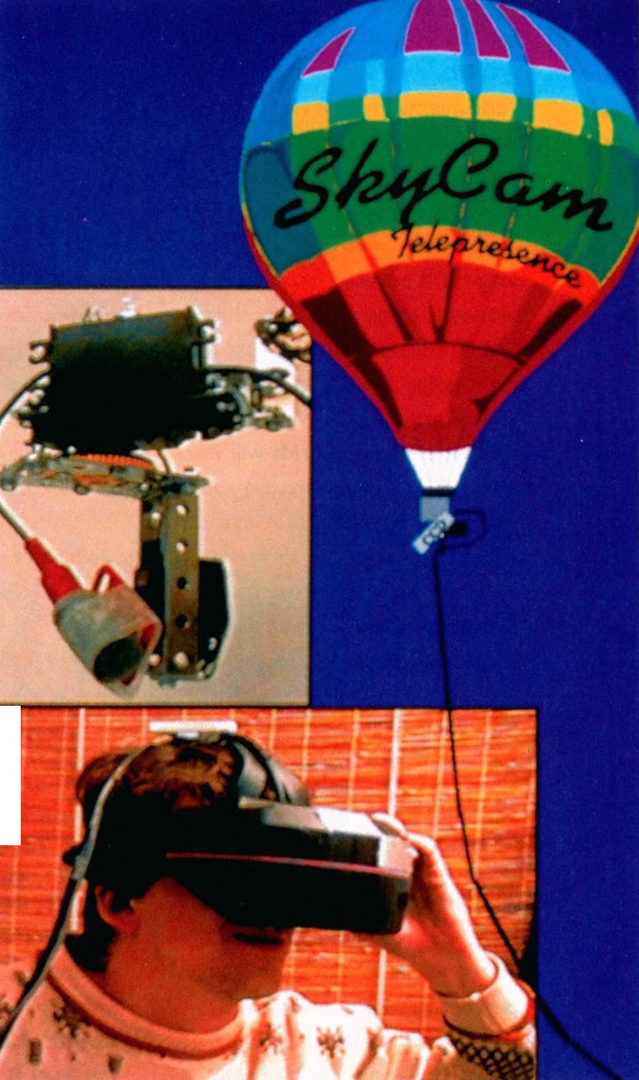“The Edge Observatory: An Airborne Telepresence System” by Tschesnok
Conference:
- SIGGRAPH 1994
-
More from SIGGRAPH 1994:


Type(s):
Entry Number: 21
Title:
- The Edge Observatory: An Airborne Telepresence System
Program Title:
- The Edge
Presenter(s):
Collaborator(s):
Description:
The Edge Observatory Telepresence system offers its operators the unique ability to visually “teleport” themselves to a remote location in the airspace above The Edge. Suspended by a helium balloon, a small motion-controlled video camera acts as the eye of the operator below, matching angular orientation with the user’s head position and feeding the video signal from above back to the operator’s headmounted display. Such an airborne telepresence system offers the user unique visual feedback in environments that are unsuited for airplanes, helicopters, or other airborne equipment. The probe’s unique size and weight render it useful for indoor use as well, making it an option for applications ranging from trade show advertising to unmanned television blimps. The overall goal of the observatory project is to raise public awareness of the many possibilities of telepresence.
From the start, the main goal of The Edge Observatory Telepresence system has been to demonstrate a practical example of how this technology has matured and become commercially feasible. Unlike computer-based virtual reality, telepresence does not require expensive computer processing power, since it does not simulate an environment; it simply transfers environmental information from one location to another. In the observatory system, the visual perspective as seen from a balloon above the conference is transferred down to the user below, who is wearing a head-mounted display (HMD). A miniature computer-controlled motion platform orients the balloon’s video camera in accordance with the operator’s head position, allowing the userto look around freely. The system puts a new twist on previous exhibits by offering a view from 40 feet above the conference.
In developing The Edge Observatory project, special consideration was given to the cost and commercial availability of the components. Except for the custom software and the mechanical structure of the video camera platform, all components were purchased at low cost from toy and hobby stores and inexpensive sources within the virtual reality industry.
The camera platform was built with a toy construction kit (Steel Tec) and servo units that are commonly used in the remote control toy/hobby market. Pitch and yaw (up/down, left/right) were implemented with two servos. Roll was omitted, since it greatly increases the mechanical complexity of the design without offering much in enhanced motion-control. A small, lipsticksized CCD video camera was the ideal choice as a video source, since its low mass makes it suitable for quick angular accelerations and keeps the total system weight to a minimum. The entire camera and motion platform assembly can fit nicely into the palm of a hand, and it weighs about nine ounces. Although a tether is used with the observatory, the servos are uniquely suited for operation with remote-controlled equipment, since they were originally designed for such systems. The only additional requirement for wireless operation is an NTSC signal-transmission system.
A VictorMaxx head-mounted display is used along with a DigiSonic, Inc. ultrasonic head tracker. This combination offered the only fully head-tracked display for under $1,000. The video signal from the camera is fed directly into the color display, and head tracker information is fed into the computer via an internal ISA peripheral.
The computer system is a low-cost 386 PC, which acts as a buffer between the head-tracking device and the motion-control system. It analyzes the head tracker orientation and matches the video camera orientation to its equivalent. The computer also stabilizes erratic accelerations and vibrations within the motion platform. If a user moves too erratically, the computer relaxes these accelerations to protect the servo system and the CCD camera from excessive forces. Orientation information is then delivered to the servos via a servo I/O board connected to the serial port.
Telepresence and telerobotics have fast-growing commercial applications and will have a profound impact on future developments in space exploration, underwater operations, and military combat. Airborne telepresence is especially well suited for terrain reconnaissance and theme park rides. Commercial advertising has yet to take advantage of the high visibility and crowd participation potential of telepresence systems such as The Edge Observatory.
An airborne telepresence probe provides simple but powerful proof that one can fly without actually leaving the ground. It is hoped that this timely and educational display conjures up new ideas for future development.




